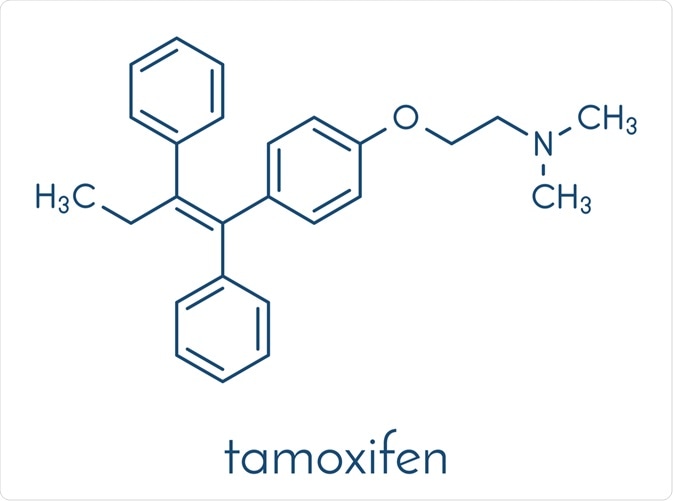Tamoxifen is both the most widely prescribed drug for breast cancer and preventative therapy worldwide. It is a synthetic derivative of triphenylethylene but was originally screened in a drug development program oriented toward discovering new post-coital contraceptive agents.
In its testing, tamoxifen had proved effective in rats but not in women. It was only in 1997 that it was FDA approved for the clinical treatment of advanced breast cancer. That had followed animal studies demonstrating that it was incredibly effective in preventative action against the development of experimentally-induced breast cancer, caused by known carcinogens dimethylbenzanthracene and nitrosomethylurea.

Image Credit: StudioMolekuul / Shutterstock
While Tamoxifen is commonly known as an anti-estrogen, this is not an accurate description of its clinical activity. In actual fact, Tamoxifen boasts both estrogenic and anti-estrogenic properties depending on the target tissue. Due to this dual-action, Tamoxifen is better described with the term selective estrogen receptor modulator (SERM).
Tamoxifen has a complex mechanism of action owing to its molecular structure. It is chemically very similar to estrogen/estradiol however estradiol is a small carbon-rich steroid and tamoxifen has an extra chain which is important for its antagonistic action.
Tamoxifen itself is a pro-drug with a relatively low affinity for the estrogen receptor. It is metabolized by the cytochrome P450 family (more specifically CYP2D6) to active metabolites such as endoxifen (4-OH-N-desmethyl-tamoxifen). Interestingly, this metabolite has been shown to bind the estrogen receptor (ER) with an almost 100-fold greater affinity than tamoxifen.
Tamoxifen’s pro- and anti-estrogenic actions are mediated by its competitive binding to the estrogen receptors (ERα and/or β) which then undergo a conformational change. The nuclear complexes that form change the expression of estrogen-dependent genes to generate multiple growth-promoting signals both inside and outside the nucleus.
For example, the prolonged binding of tamoxifen to specific genes can lead to a block in the proliferative actions of endogenous estrogen on mammary epithelium by reducing DNA Polymerase activity, blocking estradiol uptake and eventually dampening the estrogen response.
Such changes occur because the estrogen receptors function as ligand-activated transcription factors which can bind their cognate DNA sequences known as estrogen-responsive elements, and activate the transcription of factors that can either stimulate estrogen-like actions or oppose estrogen actions in estrogen target tissues. Both these genomic and additional non-genomic effects have actually been demonstrated with estradiol administration.
Tamoxifen’s strongly anti-estrogenic properties on mammary epithelium make it appropriate in both the prevention and treatment of breast cancer. With this said, its pro-estrogenic properties on uterine epithelium have resulted in the current controversy regarding its safety in cancer prevention.
This is particularly due to its association in the increased incidence of endometrial lesions (including hyperplasia, carcinomas, and sarcoma) found in women undergoing chronic treatment with tamoxifen. With time, the risk of endometrial cancer increases drastically, which is a reason tamoxifen is typically recommended for 5 years. Because of this associated danger, lowering the risk of endometrial cancer for tamoxifen users is becoming an increasingly important target in cancer prevention.
Not all of the pro-estrogenic effects are harmful. Tamoxifen pro-estrogenic action is also evident in bone matter, where it mimics the effects of estrogen and provides the signals required for bone maintenance, thereby inhibiting osteoclasts and reducing the risk of osteoporosis in menopausal women in particular.
References:
- http://www.ncbi.nlm.nih.gov/books/NBK12522/
- http://www.spandidos-publications.com/ol/9/4/1495
- http://jnci.oxfordjournals.org/content/96/12/926.full
- http://www.nature.com/onc/journal/v22/n39/full/1206769a.html
- http://www.drugbank.ca/drugs/DB00675#pharmacology
Further Reading